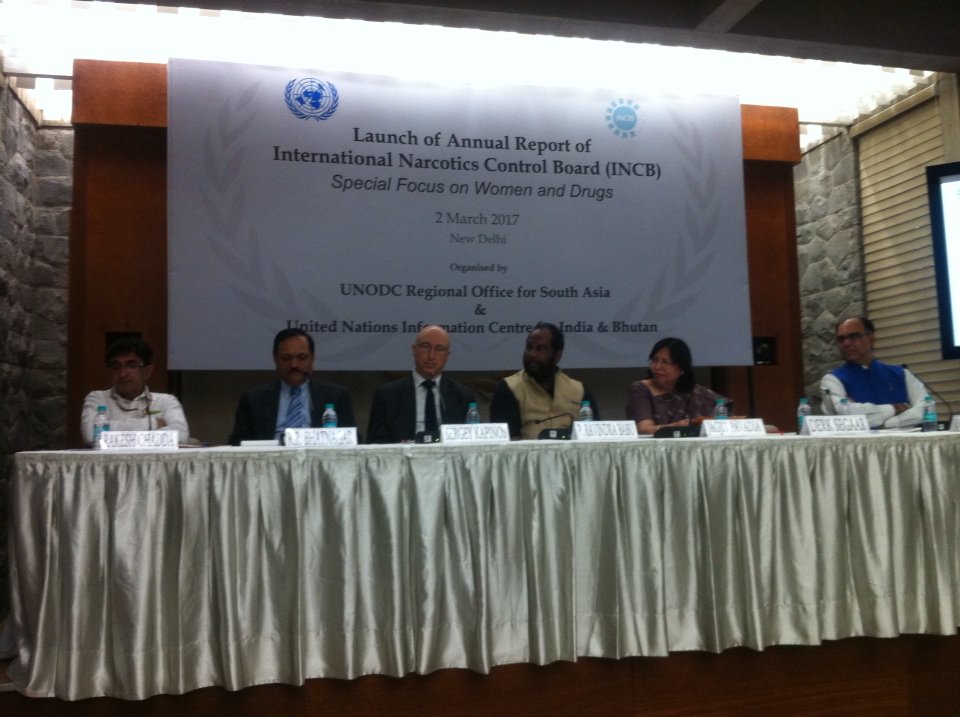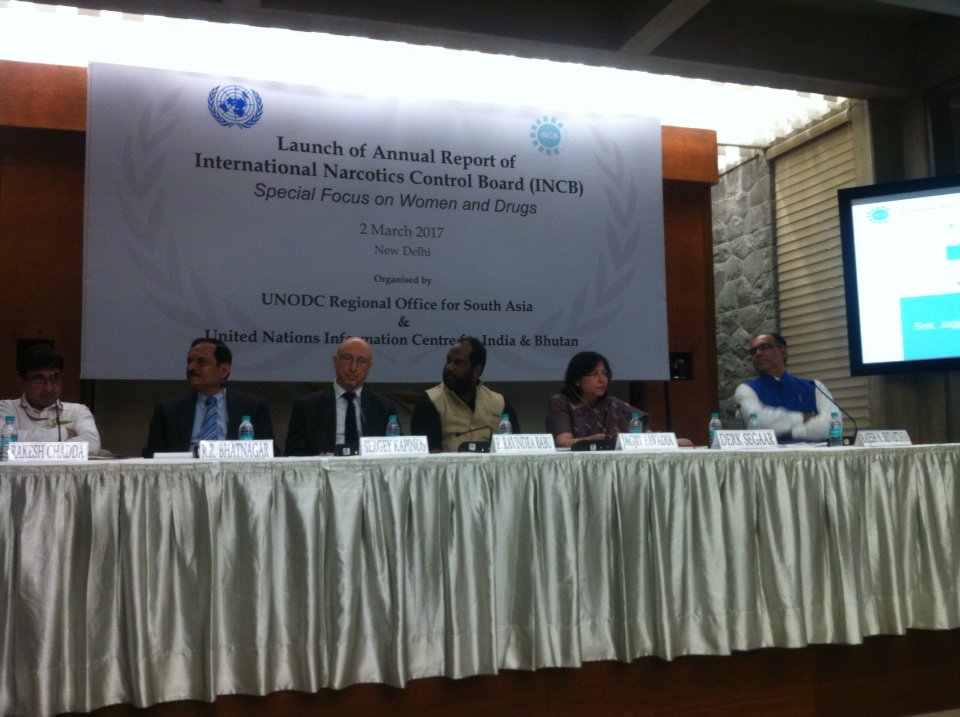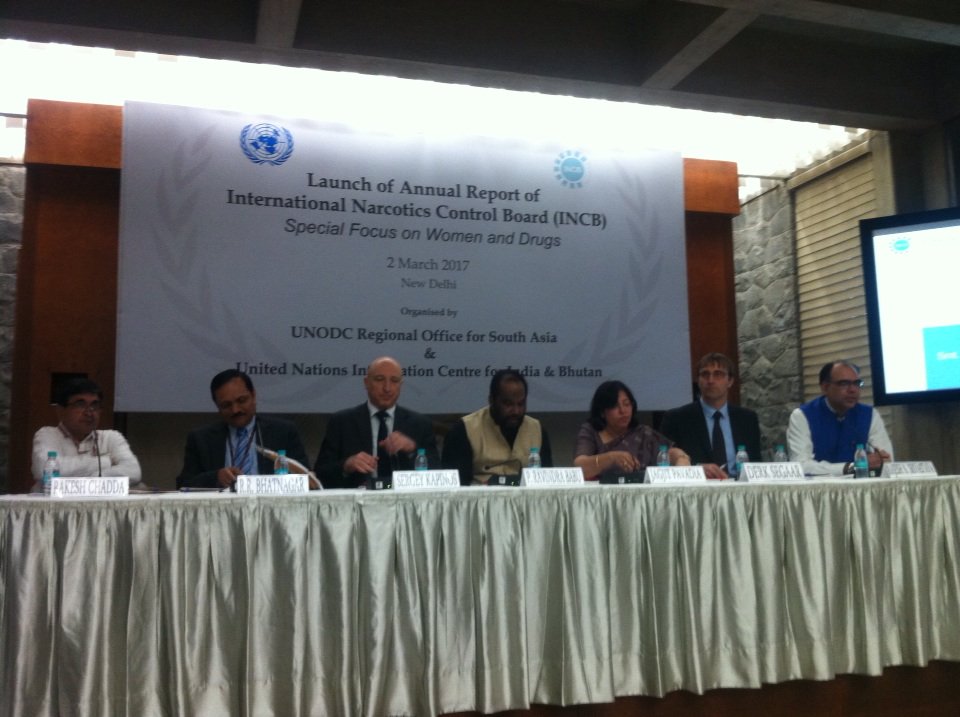The launch of Annual Report of the International Narcotics Control Board, Thursday 2 March 2017 is attached.    
Women and drugs
Women and drugsLaunch of Annual report of INCB02.03.2017 14:11:15 - Launch of Annual report of INCB ,Special Focus on Women and Drug at UNODC, N Delhi
(live-PR.com) - Women and drugs
1. There is growing awareness of the importance of appropriately incorporating a gender perspective into drug-related policies and programmes. The Political Declarations of 19983 and 20094 incorporate gender considerations, and both the General Assembly5 and the Commission on Narcotic Drugs6 have given increasing attention to this aspect over the past 10 years. In addition, the General Assembly, in its resolution on the 2030 Agenda for Sustainable critical importance of gender equality and the empowerment of women. In the outcome document of the thirtieth special session of the General Assembly, entitled “Our joint commitment to effectively addressing and countering the world drug problem”,8 Member States are encouraged to address the specific needs of women in the context of drug policy. The Commission on Narcotic Drugs, the main policymaking body of the United Nations system for drug-related matters, has adopted a number of resolutions with regard to the situation of women as it relates to the world drug problem. To contribute to the advancement of gender-sensitive policies to address this issue, the Commission has highlighted the specific needs of women, most recently at its fifty-ninth session, held in March 2016, when it adopted its resolution 59/5, entitled 3 Political Declaration adopted by the General Assembly at its twentieth special session, devoted to countering the world drug problem together (General Assembly resolution S-20/2, annex). 4 Political Declaration and Plan of Action on International Cooperation towards an Integrated and Balanced Strategy to Counter the World Drug Problem (see Official Records of the Economic and Social Council, 2009, Supplement No. 8 (E/2009/28), chap. I, sect. C). 5 General Assembly resolutions 58/138, 61/143, 63/241 and 70/182. 6 Commission on Narcotic Drugs resolutions 52/1, 55/5 and 59/5. 7 General Assembly resolution 70/1. 8 General Assembly resolution S-30/1, annex. “Mainstreaming a gender perspective in drug-related policies and programmes”. 2. Recognizing the importance of gender-responsiveness, the International Narcotics Control Board (INCB) has devoted the first chapter of the present annual report to the topic of women and drugs. However, owing to the multifaceted nature of this subject, it cannot be dealt with in an exhaustive manner in only one chapter. Moreover, data on women drug users are sparse, further complicating analysis. For those reasons, the present chapter is limited to some salient aspects: drug-related harms, special populations, prevention and treatment, and rehabilitation for drug dependence. 3. Drug-dependent women may face many difficulties: they can experience high levels of stigmatization; they can be ostracized by their family or community; they may be subjected to violence from partners or family members; and they may turn to, or be coerced into, sex work to support their drug use or that of their partner. In addition, they lack access to gender-sensitive treatment for drug dependence. The limited data available at the global level show that women drug users are increasing in number among youth and prison populations. Few countries provide adequate levels of drug-dependency treatment to women, and virtually all countries need to expand gender- sensitive treatment if they are to achieve the highest attainable standard of health for women. 4. Criminal justice data indicate that an increasing number of women are arrested for drug-related crimes. The incarceration of women involved in drug-related offences may have a catastrophic effect on their children, particularly if they are the primary caregivers. Afemale prisoners have very high levels of drug dependence but rarely have access to treatment and rehabilitation services. A. Prevalence and patterns of drug abuse 5. Women and girls comprise one third of people who use drugs globally. In 2010, the global estimated number of women dependent on amphetamines was 6.3 million; women dependent on opioids numbered 4.7 million; and women dependent on cocaine numbered 2.1 million. Women had a high prevalence of amphetamine dependence (0.31 per cent) in South-East Asia and Oceania, of opioid dependence (0.25 per cent) in Oceania, and of cocaine dependence (0.22 per cent) in North America and Latin America. Also in 2010, an estimated 3.8 million women injected drugs globally, corresponding to 0.11 per cent of the world female population.9 Drug-use patterns among women reflect differences in opportunities to use drugs, which are a result of the influence of their social or cultural environment. 6. Generally, women start using drugs later than men do, and their use is strongly influenced by partners who also use drugs. However, once women start abusing drugs, their rate of consumption of cannabis, opioids and cocaine progresses more rapidly than among men, and they tend to develop a substance use disorder more quickly than men do. In the case of methamphetamines, women begin using them at an earlier age than men, and they are more likely to have a methamphetamine use disorder than men. Compared with men, women who use heroin are younger, likely to use smaller amounts and for a shorter time, are less likely to inject the drug and are more likely to be influenced by drug-using sexual partners. Often, someone else, typically their partner, will administer a woman’s first injection of drugs. 7. Women in high-income countries have a higher level of drug use than women in low- and middle-income countries. In terms of abuse of all drugs, the gap between women and men is narrower among the youth population than among the adult population. Women also constitute a large proportion of those abusing prescription 9 Harvey A. Whiteford and others, “Global burden of disease attributable to mental and substance use disorders: findings from the Global Burden of Disease Study 2010”, The Lancet, vol. 382, No. 9904 (2013), pp. 1575-1586. drugs. The Pompidou Group of the Council of Europe reported that the use of prescription drugs by women increases according to age group, peaking among women in their thirties. Although data are limited, both Germany and Serbia reported that fatal overdoses owing to prescription drug abuse were more common among women than among men.10 Studies show that women are more likely to use prescription drugs, such as narcotic analgesics and tranquillizers (e.g., benzodiazepines), for nonmedical purposes.11 This is compounded by the greater vulnerability of women to depression, anxiety, trauma and victimization compared with men. Women report using drugs to cope with stressful situations in their lives, and there is evidence that women are significantly more likely than men to be prescribed narcotics and anti-anxiety medications.12 8. The prevalence of illicit drug use, drug abuse by injection and drug dependence is consistently higher among women who have sex with women. Among transgender women, drug abuse, including by injection, is also common, ranging from approximately 30 per cent in the United States of America, to 42 per cent in Australia and up to 50 per cent in Portugal and Spain. However, a study carried out in 2004 in Pakistan found that fewer than 2 per cent of transgender women had injected drugs in the previous year. C. Drug-related harm 1. HIV infection, overdose and other negative health consequences 16. Studies of drug abuse and its related harms often do not specifically consider women, in turn limiting the accurate assessment of how various issues affect women who use drugs. Furthermore, most research is undertaken in high-income countries, thus limiting the global understanding of the situation. Nevertheless, a reasonable amount of data on HIV among women has been generated, providing some indication of the problem, given the link between injecting drug use and the risk of HIV infection. HIV prevalence among female drug users can range vastly, from low levels in several countries to over 50 per cent in some others, such as Estonia and the Philippines. In the United Republic of Tanzania, 72 per cent of women who abuse heroin by injection are HIV positive, compared with 45 per cent of men. In Senegal, HIV prevalence among women who abuse drugs by injection is three times higher than among men. 17. Overall, even in generalized epidemics in sub-Saharan Africa, female sex workers are 12 times more likely to be HIV positive than the general female population. Similarly, in other environments with medium or 19 India, Ministry of Social Justice and Empowerment, and UNODC, Regional Office for South Asia, “Women and drug abuse: the problem in India—highlights of the report” (New Delhi, 2002). high prevalence of HIV, or generalized HIV epidemics, the likelihood of HIV infection was found to be high.20 Female prisoners also have higher rates of HIV infection compared with both the general population and male prisoners.21 18. Women who inject drugs frequently report sharing needles, giving reasons such as being unaware of the risks, being unable to obtain needles from pharmacies and being afraid of being caught by police. Some women report that they share needles with their partner as a sign of love or trust. Poor injecting techniques cause vein injuries with severe complications. Women injecting drugs face problems such as fatigue, weight loss, withdrawal pain, depression and suicidal tendencies; many also have sexually transmitted infections and hepatitis. For these women, access to health care is mainly hindered by the stigma attached to women who abuse drugs by injection. 19. In 2012, more than 15,000 women died from drug overdoses in the United States. Between 1999 and 2010, the number of deaths related to the use of prescription opioid painkillers among women in the United States increased by a factor of 5, while the rate for men increased by a factor of 3.6. A review of mortality data in the United Kingdom of Great Britain and Northern Ireland from 2007 to 2008 revealed larger increases in overdoses (of all substances) among women than among men (17 per cent for women and 8 per cent for men). In particular, there was an 8 per cent increase in the number of deaths of women from heroin/morphine overdose and a 20 per cent increase in the number of deaths of women from cocaine overdose during that period.22 2. Mental illness 20. The dual occurrence of substance use disorder and mental illness is difficult to diagnose and treat and is more common in women than men. If women who suffer from this dual occurrence are not treated they will have poorer clinical outcomes than women with a single disorder. In Europe, co-morbid major depression is more frequent in women with substance use disorders.
|
Donation-At:HDFC-A-3-Janakpuri-New-DelhiA/cNo-15581000026895:Details for donation of Amount-Please enter Name* Email * Address*
Thursday, March 2, 2017
Subscribe to:
Post Comments (Atom)
NASA : Search for Alien Life on Saturn’s Moon On Thursday NASA announced a mission to land a car-sized robot quadcopter on S...
-
GOVERNMENT TO REVIVE NORTH KOEL IRRIGATION PROJECT Posted on April 8, 2017 Centre has decided to revive the North Koel Irrigation pr...
-
SAB TV promises a Magical Comedy with Baal Veer ~Starting 8 th October every Mon-Friday at 8pm~ New Delhi,September 27 th...
-
Smriti Mehra looks forward to a second consecutive title at the third leg of the Hero Women’s Pro Golf Tour 2013 Mumbai, 25 th Feb 201...
No comments:
Post a Comment